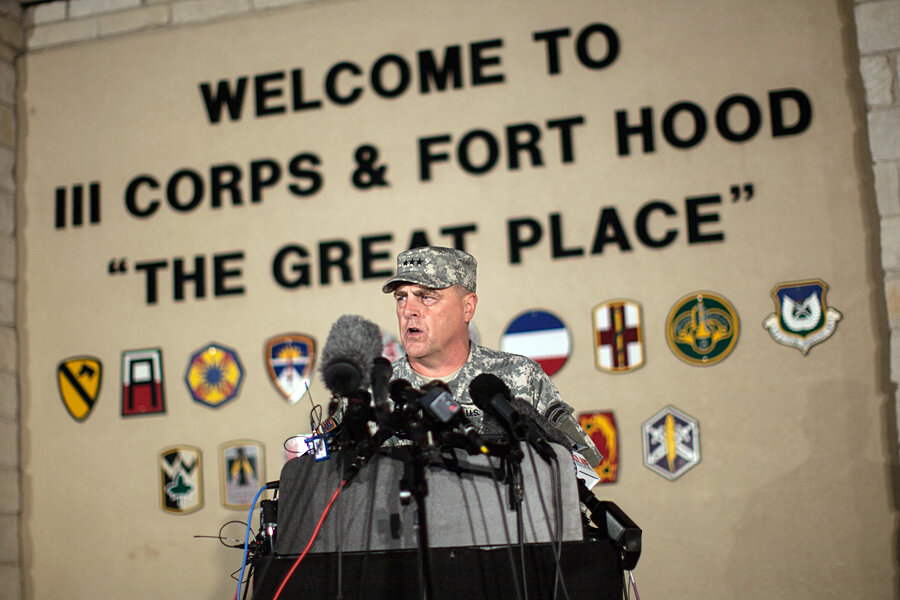Ivan Lopez: Truck driver. Dad. Drummer. Portrait emerges after Fort Hood attack.
Loading...
Emerging information about Army Spc. Ivan Lopez, who killed three people and injured 16, some critically, at Fort Hood on Wednesday, paint a picture of a troubled, perhaps injured soldier who was seeking treatment for mental problems before his transfer two months ago to the Texas Army base.
The Iraq war veteran, who drove a truck for his unit, is at the center of an investigation into the third major attack by a service member on his own comrades in five years. When a Fort Hood police officer drew her gun to confront Lopez during a barrage that involved two buildings at the base, he turned his .45 caliber handgun on himself, officials say.
Military officials, the FBI, and civilian police are now delving into Lopez’s past in search of a possible motive.
Lopez, originally from the Puerto Rican village of Guayanilla, was a percussionist and former National Guardsman who had spent time in Egypt on a mission in the mid-2000s. His mother and grandfather recently died, according to El Nueva Dia, a Puerto Rican newspaper. He left the National Guard in 2010 to join the US Army.
He had recently moved to Killeen, Texas, with his wife and 3-year-old daughter from another Army base in Texas, neighbors say.
Lopez was being evaluated for post-traumatic stress distorder (PTSD) but had not been diagnosed with that illness, Fort Hood officials say. They also say that he had reported a brain injury – a concussion apparently not related to his military service.
Lopez spent four months in Iraq in 2011, the year the US ended its combat mission there. Military officials are reporting that there are no records showing Lopez was engaged in combat during his tour there.
So far, investigators have found no evidence that Wednesday's attack was terrorism-related, though that possibility has not been ruled out. Fox News had reported a day before the shooting that the FBI was searching for a recent Army recruit believed to be planning a “jihad-style” attack at Fort Hood. But the name of that suspect, as reported by the FBI, is not Ivan Lopez.
Officials at Fort Hood, however, suggest a singular precipitating event may have sparked the shootings.
"Obviously, we are digging deep into his background, any criminal or psychiatric history, his experiences in combat. All of the things you would expect us to do are being done right now,” Lt. Gen. Mark Milley said late Wednesday. "There are initial reports there may have been an argument in one of the unit areas.”
Lopez had arrived at Fort Hood, the scene of the horrific 2009 attack by self-avowed jihadist Maj. Nidal Hasan, in February. He drove trucks for the 13th Sustainment Command (Expeditionary), but had not been assigned to the base’s Army Wounded Transition Units that help injured soldiers return to service.
The shootings began when Lopez walked into a building Wednesday afternoon and opened fire. He then got into a vehicle, and kept on firing before entering another building. Upon leaving it, he was confronted by the military police in a parking lot. All the victims were soldiers.
Last year, Major Hassan was sentenced to death for committing the worst attack on a US base in history, killing 13 fellow soldiers and injuring scores of others at Fort Hood in November 2009. Hasan said in court filings that he attacked soldiers about to ship out to Afghanistan in a bid to protect Islamic insurgents abroad.
Then in September, Navy veteran Aaron Alexis killed 12 people and then himself at the Washington Navy Yard. The FBI said Mr. Alexis had "the delusional belief that he was being controlled or influenced by extremely low frequently electromagnetic waves.”
The Pentagon has responded to the shootings with a variety of initiatives, but Defense Secretary Chuck Hagel said after Wednesday’s tragedy that the repeated soldier-on-soldier attacks on military installations suggest that “something’s not working.”








